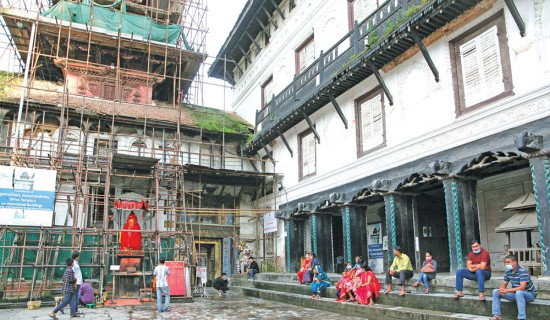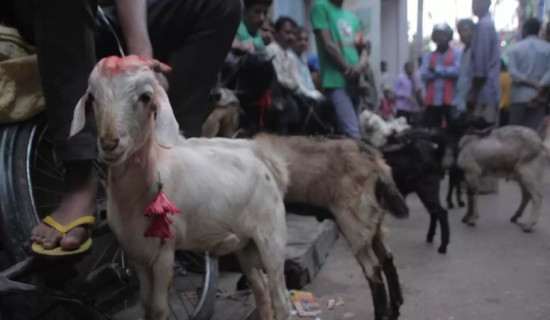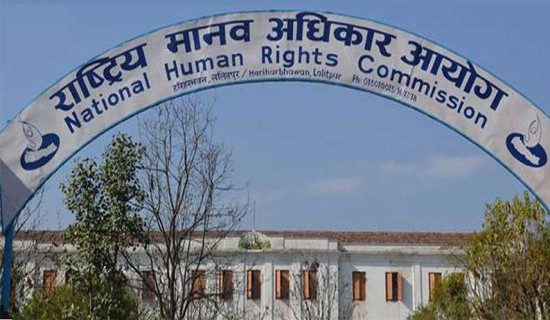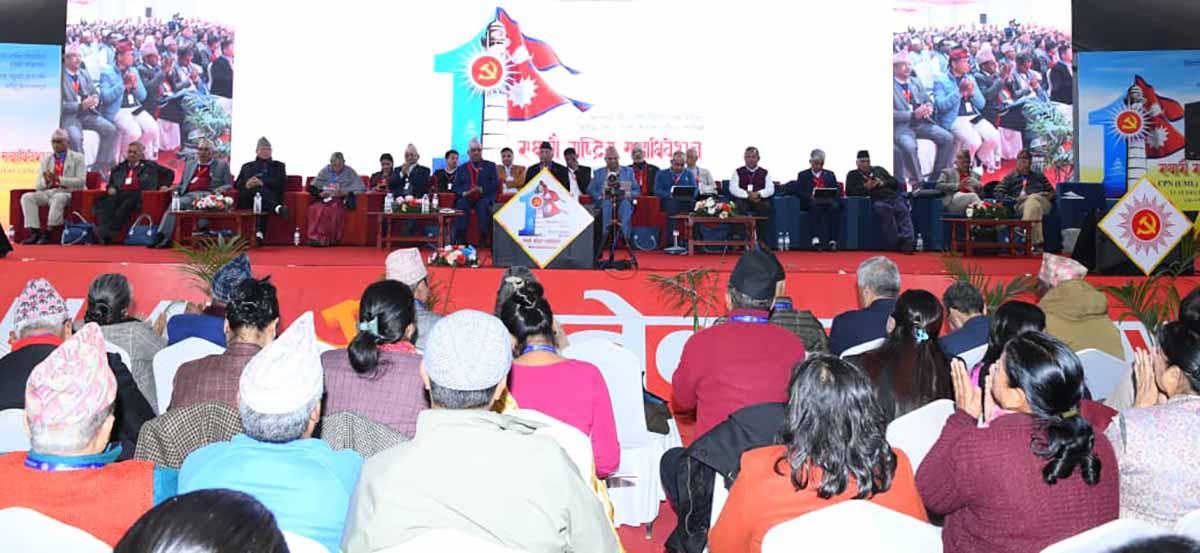- Monday, 15 December 2025
Quake-damaged heritage reconstruction on, albeit slowly
On Tuesday this week, the 700-year-old Lakshmi Narasimha Temple was inaugurated. The temple, which had been completely destroyed in the 1934 earthquake, is located in Gahiti, Ward No. 4 of Bhaktapur Municipality. Bhaktapur Municipality completed the temple's reconstruction 91 years after it was damaged at a cost of Rs. 48.3 million—well below the estimated cost of Rs 77.7 million.
Neglected monuments within Dharahara complex
Hundreds of visitors have been visiting the new 22-storey Dharahara Tower daily since it was open to the public a few months ago.
Entertainment sector workers face risk of exploitation
Sarawati Bishwakrma, who is working at a Lok Dohori as a singer, has not received her salary for two months and has been working without a labour agreement for the past five years. She has requested the c
Dharahara draws crowd of visitors
Two Buddhist monks were watching their mobile phones sitting in the shadow of the 82-metre tall newly rebuilt Dharahara on Friday afternoon. They were probably waiting for their turn to climb the tower
Theft of idols affects traditional Jatra
This week, locals in Chapagaun of Lalitpur celebrated Marthi Jatra, almost four decades after the main idol was stolen from the temple. The Jatra was not celeb
Public transport still inaccessible to people with disabilities
Most public transportation remains inaccessible to people with disabilities, even 11 years after the 'Accessible Physical Structure and Communication Service Directive for Persons with Disabilities, 2013 was introduced.
Gundu farmers busy making Makhamali garlands for Tihar
As Tihar, the second biggest festival of Nepali people, is around the corner, the farmers of Gundu in Suryabinayak Municipality-7, Bhaktapur, are now busy picking Makhamali (globe amaranth) flowers and making garlands.
Animal sacrifice rituals during Dashain festival
The mass sacrificial ceremony is specially organised at the Taleju Temple of Hanuman Dhoka of Kathmandu, Patan and Bhaktapur to offer to the goddess during Maha Ashtami and Maha Nawami.
Khokana people mark Sikali Jatra during Dashain
Khokana, located south of the Kathmandu Valley, is famous for mustard oil and beaten rice across the country. However, many people do not know another feature of Khokana—people here do not celebrate Dashain, the biggest festival of Nepalis. When the entire nation is preparing to celebrate Dashain, the people of Khokana in Ward No. 21 of Lalitpur Metropolitan City are busy marking the festival of Rudrayani, popularly known as Sikali Jatra.
Rehearsal of Mahakali dance for Indra Jatra begins
Kathmanduites are now preparing to mark their biggest Jatra, Indra Jatra, known as Yenya in the local language. This year, the annual Jatra of Living Goddess falls on September 17. Street mask dances are one of the major features of the Jatra, and Mahakali dance is one of them. Seven
Digu Tole tongue-piercing festival being held next week
Bode, an ancient city of Madhyapur Thimi, is known for its famous tongue-piercing festival, but many people may not know about another tongue-piercing festival of Digu Tole in Ward No. 5 of Madhyapur Thimi Municipality. This tongue-piercing festival is taking place on next Wednesday evening.
Mahakali and Bhairav dances of Nagadesh concluding today
The Prajapati community of Nagadesh Tole, which revived the historically and religiously significant Mahakali dance after a gap of 80 years in 2022, has started performing this year’s dance. Similarly, the performance of the Thimi Bhairav (Bhaila) dance has begun at Tahanani Tole of Ward No. 5 of Madhyapur Thimi, where the dance is being shown after a gap of 21 years.
Septuagenarians performing Nilbarahi dance of Bode
Bode, the ancient town of Madhyapur Thimi Municipality in Bhaktapur district, is widely known for its tongue-piercing festival. It is also a place where traditional Nilbarahi dance is performed every year. Howev
Stolen Basuki image retrieved, restored
The stolen idol of Basuki Nagraja in Sankar Kirti Mahabihar, Bhagwan Bahal of Naxal Ward No. 1 of Kathmandu Metropolitan City, was restored to its original place on Monday. The idol of Basuki Nagraja was stolen from the Bahal premises.
‘Transitional justice should be victim-friendly’
The National Human Rights Commission (NHRC) has unveiled its works related to transitional justice by organising a press meet here on Monday. The Commission has submitted its opinion prepared based on various discussions held at the national level and studies conducted at the international level for the fourth time to the sub-committee formed under the Law, Justice and Human Rights Commission for clause-wise discussions of the Bill on Investigation of Disappeared Persons, Truth and Reconciliation Commission Act, 2071 (third amendment). The main 11 points of the concept presented include truth-seeking and investigation, justice and prosecution, reparations and amnesty.

















